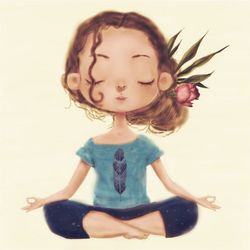

Maintaining mental health in a stressful life is one of our biggest challenges. Maintaining mental health is hampered by work stress, daily routine, relationship stress or any other reason. There is no need to take special care of the health of the mind. It is not considered. But how to get this peace of mind? One of the surest and best ways to achieve peace of mind is through yoga! According to the Patanjali Yoga Sutras (AD 500 BC), the definition of this type of yoga is as follows:
Yoga is the inhibition of the mind '
Yoga means movement
and self-realization comes to a halt. In this article, we will use the word 'mind' instead of leopard, 'yoga means' calming the mind. '' The Bhagavad Gita says: And yoga always keeps the mind balanced when dealing with failure.From the above two verses, one thing is proved that yoga is related to the mind. At the same time, according to the popular concept of yoga, yoga means various physical states, i.e. asanas. These asanas are beneficial for physical fitness. How can a person combine the two? If you understand it well, you can know the secret: Sthir Sukham Asanam
Suppose you are wearing very tight shoes. So if you find it difficult to walk properly, do you suffer? But what do you think if you take off your shoes? Isn't that a comforting moment? This is the state of mind. Asanas are a physical condition, which, if done properly, calms the mind, and the emptiness that the mind gets from it remains eternal. Therefore, the main purpose of Asanas is to bring the mind into a physical state with a view to staying calm in an eternal state. This is the true meaning of burning up of bad psychic imprints. So, at first glance, it may seem that a person practicing yoga is doing physical asanas. But in fact, the person is observing this type of exercise that can calm the mind. The person does yoga to calm the mind and to maintain this state of mind. Therefore, yoga is done for a longer period of time than any other type of exercise.Yoga is the first choice of most people to maintain their physical and mental health.
Now the question arises, in which physical condition can one experience peace of mind. The answer is found in one of the verses in the Bhagavad Gita:
It means to keep the 'body, head' and neck in a straight line and to keep the physical position stable.
Yogacharya B.K.S. Iyengar says the hole 'alignment leads to' enlightenment ', the left side of the body and The right side should be properly balanced. When the body balances in such a way in any
position, it achieves physical balance in a way. The mind perceives this state, that is, the mind is also balanced, and this state becomes an asana. This state of equilibrium of body and mind is seen in the Hatha Yoga Pradipika: At that time, the mind was also troubled. Similarly, when a person breathes steadily, the mind also becomes stable. ' One thing is for sure, the breath is stable when the asana is done and the body is stable when the pranayama is done. So in perfect asanas, pranayama is an integral part, and in perfect pranayama, asana is natural. The result of pranayama is:
Dharanasucha Yogyata Manas: 'Dharana is an important aspect of Yogasadhana. By holding, the mind voluntarily concentrates on a point or part of the body.
In perception, the senses are calmed (withdrawn). This causes the person to forget about his surroundings and not be distracted by anything else. Meditation is the constant, continuous concentration on a single point or part. The intensity of paying attention to the mind does not diminish or diminish while meditating in solitude, as when pouring oil from a pot, the edge of the oil is steady, smooth and It becomes permanent just like that. The person is not aware of time and space as well as the 'self', because all the sources of the mind are concentrated at one point. Action and consciousness come together. So the way experience is the reward T 'auto-telecom.
When the action is the reward no other desires or aspirations remain. The person's behavior naturally and spontaneously tends to follow the principles of Yama (moral discipline). These include Satya, Ahimsa, Asteya, Aparigraha, Brahmacharya. When these qualities are adopted, then one feels calm and the whole world feels calm. Full concentration.
If so, meditation can be achieved in asanas and pranayama. According to modern psychologists, A person can receive a limited amount of new information at a time. When a person of
is concentrated in the seat,
they are not aware of the surrounding situation,
the environment and even the physical needs. This happens because
the person's entire attention is focused on that seat or pranayama
and on the other hand there is no
(mind / attention) available to focus on. The relationship between asanas and pranayama and the peace of mind experienced while doing it (asanas and pranayama). This is the modern explanation.












